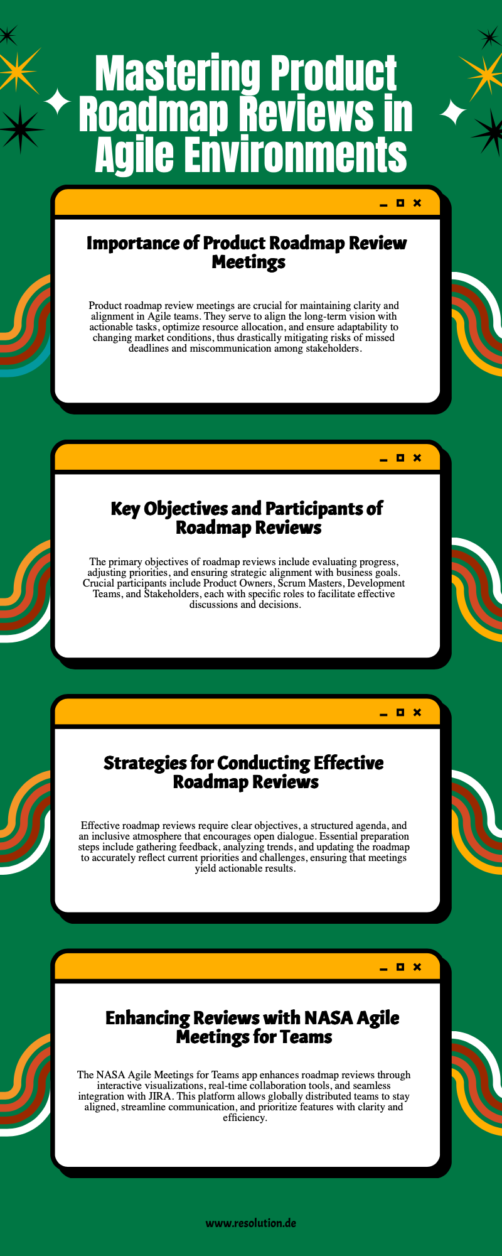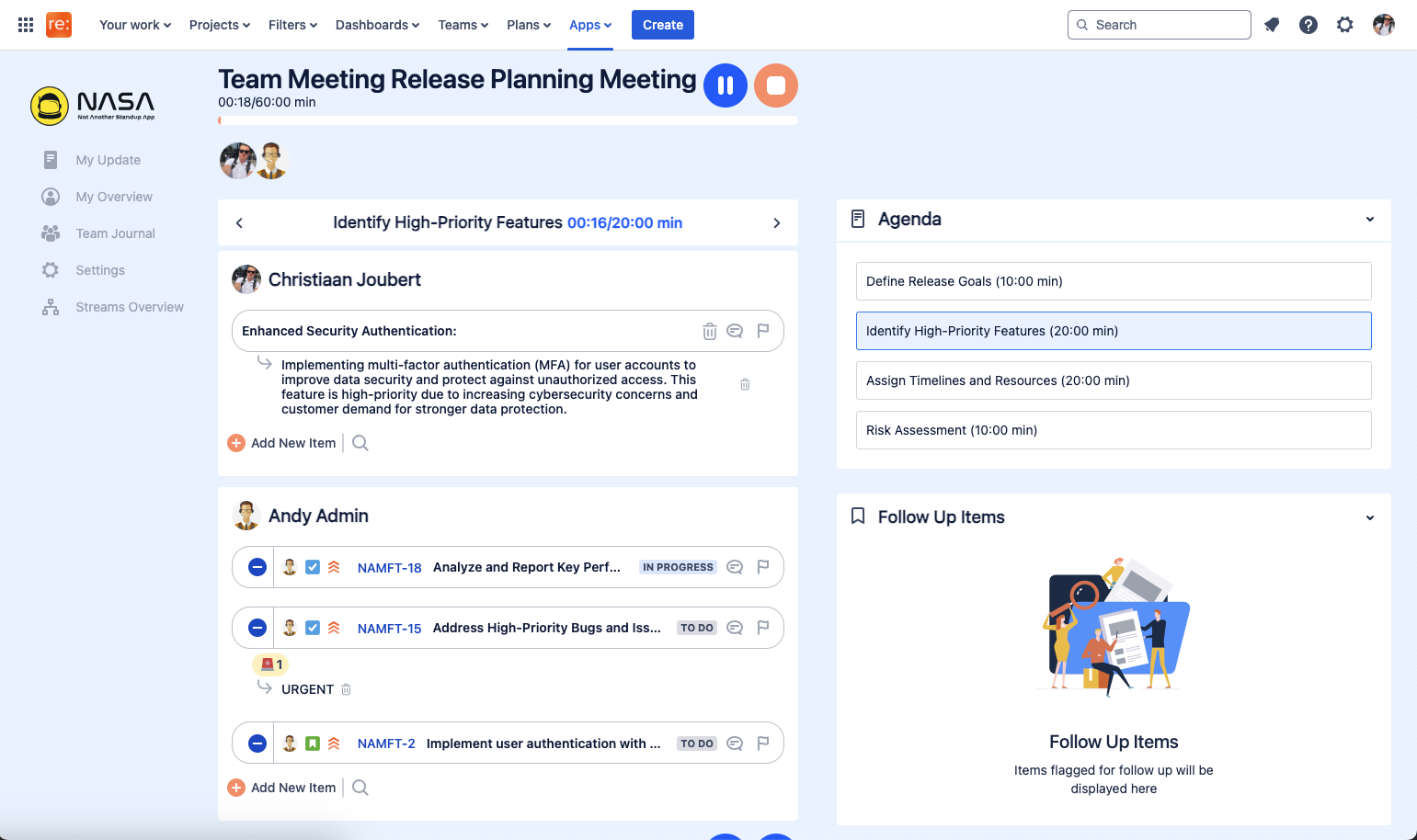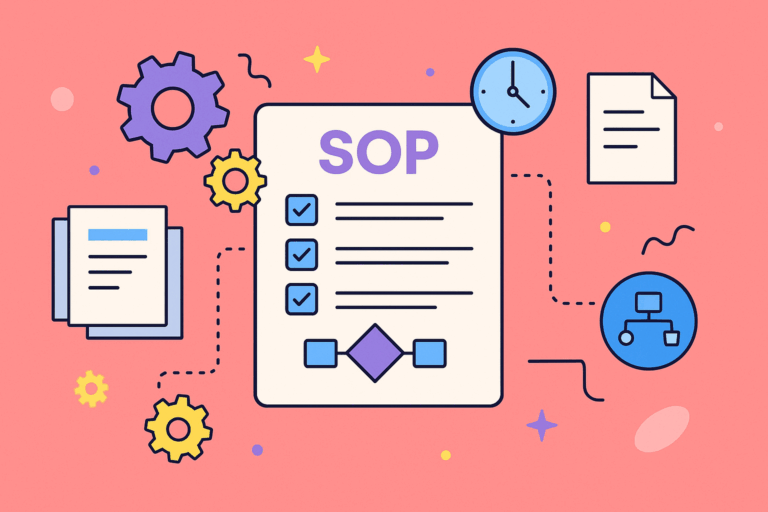Product roadmap review meetings are pivotal in Agile methodologies, serving as structured forums where teams assess progress, align priorities, and strategize future developments. They are essential for ensuring that product teams stay aligned with both customer needs and overarching business objectives.
In Agile environments, where iterative development and responsiveness to change are core principles, roadmap reviews become a compass for decision-making. These meetings allow teams to recalibrate their efforts in response to shifting market conditions, stakeholder feedback, and evolving company goals.
This blog will provide a comprehensive guide to mastering product roadmap reviews, showcasing best practices, and spotlighting how NASA Agile Meetings for Teams can elevate your success. Whether you’re a Product Owner, Scrum Master, or stakeholder, you’ll discover actionable insights to refine your roadmap processes and enhance collaboration.
Key Takeaways
Here’s what you’ll learn:
The critical role of product roadmap review meetings in Agile practices.
Key participants and their responsibilities in these meetings.
Best practices for conducting efficient, results-driven roadmap reviews.
How NASA Agile Meetings for Teams simplifies and enhances these processes.
By the end, you’ll be equipped to run impactful roadmap reviews that drive alignment, improve productivity, and ensure strategic focus.
Understanding Product Roadmap Review Meetings
A product roadmap review meeting is a recurring session where teams evaluate the progress of their product strategy, identify potential roadblocks, and realign priorities to stay on course. It’s a collaborative effort involving key team members and stakeholders, with the goal of ensuring the roadmap reflects current realities and future ambitions.
These meetings address key questions such as:
What progress has been made? Reviewing milestones and deliverables.
Are priorities still aligned? Assessing the relevance of planned features.
What adjustments are needed? Identifying changes based on feedback or market trends.
Product roadmap reviews are more than operational check-ins; they are strategic conversations that shape the product’s trajectory.
Core Participants
Product Owners: Drive the discussion, presenting the roadmap and articulating priorities.
Scrum Masters: Ensure smooth facilitation and adherence to time constraints.
Development Teams: Provide updates on deliverables and highlight technical challenges.
Stakeholders: Offer input on alignment with business and customer objectives.
Importance of Product Roadmap Reviews
Product roadmap reviews are indispensable for maintaining clarity and alignment in Agile teams. Here’s why:
Vision Alignment
Roadmap reviews ensure all team members understand the product’s long-term vision and their role in achieving it. Misalignment can lead to inefficiencies, wasted resources, and dissatisfaction among stakeholders.Resource Optimization
By regularly revisiting priorities, teams can focus on high-impact features and avoid investing in low-value tasks.Adaptability
In fast-changing markets, regular reviews enable teams to pivot effectively, incorporating customer feedback and responding to competitors.
What Happens Without Effective Roadmap Reviews?
Missed Deadlines: Poor visibility into progress can derail timelines.
Scope Creep: Without clear boundaries, additional features can disrupt focus.
Stakeholder Misalignment: Disparate expectations may lead to conflicts and delays.
Key Objectives of a Product Roadmap Review Meeting
The objectives of a roadmap review are straightforward but critical:
Progress Evaluation: Are deliverables on track? Are there any blockers?
Priority Adjustment: Should we reorder tasks based on recent developments?
Strategic Alignment: Does the roadmap still align with business goals and customer needs?
Achieving these objectives ensures the team’s efforts are impactful and aligned with overarching priorities.

Who Should Attend a Product Roadmap Review Meeting?
The success of a roadmap review depends on having the right participants. Here’s who should be at the table:
Product Owners
Responsible for presenting the roadmap and leading discussions.Scrum Masters
Facilitate the meeting, ensuring productive dialogue and time management.Development Team Members
Provide updates on tasks, highlight risks, and discuss technical feasibility.Stakeholders
Represent the business perspective, ensuring alignment with strategic goals.
Roles and Responsibilities
Each participant has a defined role:
Product Owners: Lead discussions, communicate the roadmap, and gather feedback.
Scrum Masters: Moderate the session, ensuring focus and inclusivity.
Development Teams: Share progress and flag challenges or dependencies.
Stakeholders: Validate priorities and provide high-level direction.
Clearly delineated responsibilities streamline the review process and foster collaboration.
Preparation Steps
Preparation sets the foundation for a productive meeting. Follow these steps:
Gather Feedback
Collect insights from stakeholders, customers, and team members.Analyze Trends
Review market conditions, competitive dynamics, and customer feedback.Assess Progress
Compare actual progress against planned milestones.Update the Roadmap
Incorporate new data, refine priorities, and prepare visual aids for clarity.
How to Conduct an Effective Product Roadmap Review Meeting
A well-structured meeting ensures actionable outcomes. Here’s a step-by-step guide:
Define Objectives
Set clear goals for the meeting, whether it’s to realign priorities, address blockers, or validate progress.Create an Agenda
Share the agenda in advance to ensure participants come prepared.Facilitate Open Dialogue
Encourage contributions from all attendees to foster a collaborative atmosphere.Review the Roadmap
Discuss progress, upcoming tasks, and any proposed changes.Document Agreements
Record decisions and action items to ensure accountability.
How NASA Agile Meetings for Teams Enhances Product Roadmap Reviews
The NASA Agile Meetings for Teams app offers robust tools to simplify and optimize roadmap reviews.
Key Features
Interactive Visualizations
Clear, dynamic visual tools make roadmaps easy to understand and discuss.Collaboration Tools
Real-time updates and shared workspaces enhance team engagement.JIRA Integration
Seamless synchronization with JIRA ensures consistency across platforms.Feedback Templates
Pre-built structures streamline stakeholder input, reducing preparation time.
Real-World Impact
Consider a globally distributed team using the app: stakeholders from different time zones can access updates in real-time, reducing delays and fostering alignment. Teams can collaboratively prioritize features without miscommunication, thanks to integrated feedback channels.

Summary
Mastering product roadmap reviews is essential for driving Agile success. By focusing on alignment, prioritization, and adaptability, these meetings ensure that teams are working toward meaningful objectives. Tools like NASA Agile Meetings for Teams amplify the impact of these reviews, making them more efficient and collaborative.
Are you ready to elevate your product roadmap review meetings?
Schedule a demo to explore how NASA Agile Meetings for Teams can transform your process.
Visit our product page for in-depth insights.
Download the app today on the Atlassian Marketplace and take the first step toward consistent product success.
Frequently Asked Questions
How often should roadmap reviews occur?
Monthly or quarterly, depending on project complexity and market dynamics.
What tools enhance roadmap reviews?
NASA Agile Meetings for Teams, JIRA, and ProductPlan are excellent options.
How do you handle conflicting priorities?
Use frameworks like RICE (Reach, Impact, Confidence, Effort) to objectively rank tasks.
By following these guidelines and leveraging the right tools, you can make roadmap reviews a powerful driver of product success.
Mastering the Product Roadmap: A Practical Guide for Success
What is a Product Roadmap?
A product roadmap is a strategic document that outlines the vision, direction, priorities, and progress of a product over time.
It’s a plan of action that aligns the organization around short and long-term goals for the product or project, and how they will be achieved.
A product roadmap is a tool for communicating your product plans and putting them into action.
It outlines high-level goals and initiatives, releases and features that support them, and a timeline for implementing the work.
Why Are Product Roadmaps Important?
Product roadmaps are indispensable in product management because they serve several critical functions, including aligning stakeholders, communicating priorities, and guiding product development.
The biggest benefit of the product roadmap is the strategic vision it illustrates to all stakeholders.
A product roadmap is a promise to the team and customers that you will be accountable to the most meaningful work.
Product Strategy and Roadmap Alignment
The essence of a product roadmap lies in its alignment with the company’s overarching business strategy.
It’s not just about what your product will do; it’s about how your product will propel the business forward.
A product roadmap should be a comprehensive guide that sets clear objectives, prioritizes features, and continuously gathers feedback from stakeholders.
Creating a Product Roadmap
Define Your Product Vision and Mission
Setting strategic product goals and initiatives is an important first step in building a roadmap.
Strategy is the “why” behind your product.
A strong product vision captures who your customers are, what they need, and how you will go to market with your offering.
Review and Manage Ideas
Most product teams have a constant influx of product ideas from customers and customer-facing internal teams.
When these ideas are organized and prioritized, they are valuable input for deciding what to put on your roadmap.
Use a product prioritization framework to take a more quantitative approach for assessing inputs.
Define Features and Requirements
This is when your product roadmap starts to take shape.
Use a template or tool to put your features into words, add the necessary details in the requirements, and group related ones into epics (if needed).
Consider using a tool that organizes all insights in one place.
Organize into Releases
Once your features are prioritized and sorted, you can plot out your delivery timeline with releases.
Releases are often organized by product launch but some teams prefer to arrange their roadmaps based on development capacity.
Consider using a product roadmap software to build a custom roadmap that is dynamic and collaborative.
Product Teams and Roadmap Collaboration
Product roadmaps are not just for product managers or their team members; they are crucial tools for aligning internal and external stakeholders.
Involving stakeholders in the roadmapping process does several things, including providing valuable feedback and helping to inform sales strategies.
Cross-functional teams, including development teams, should be involved in the roadmapping process to ensure everyone is on the same page.
Presenting the Product Roadmap
The product roadmap needs buy-in from two key groups: leadership and the agile development team.
Presenting the roadmap is a great opportunity to demonstrate to key stakeholders that you understand the company’s strategic objectives, the needs of your customer, and have a plan to meet them both.
As you move through the project, make sure to link your delivery team’s work back to the product roadmap for context and visibility into progress for your team and stakeholders.
Using and Updating the Roadmap
Roadmapping doesn’t end once you’ve reached your final state.
As the competitive landscape shifts, customers’ preferences adjust, or planned features are modified, it’s important to take any learnings or insights, feed them back into your team’s discovery process and ensure the product roadmap continues to reflect the status of current work as well as long-term goals.
Keep customers informed about changes to the product roadmap and involve them in the product development process.
Product Managers and Roadmap Ownership
The product manager owns the product roadmap and is responsible for building it.
The product manager leads the charge in collecting research, ideas, and feedback, translating and prioritizing these materials into features, and building the roadmap itself.
The product roadmap is a central place to come together around the Complete Product Experience (CPE).
Best Practices for Effective Roadmaps
Building and maintaining product roadmaps is as much an ongoing process as it is a cultural practice to embark upon with your product team.
There are a few simple ways to set yourself up for success, including using a product roadmap software and involving cross-functional teams in the roadmapping process.
Embracing Flexibility
Rigidity is your enemy; after all, market conditions change, customer preferences evolve, and new competitors emerge.
Your roadmap needs to be flexible enough to adapt to these changes, and it’s about being agile, not just in the product development process but in planning and strategizing.
Consider using an agile product roadmap to suit your organization’s needs.
Product Roadmapping Tools
As you can see, every product roadmap has many variables, considerations, dependencies, and specificities, so it should come as no surprise that no two product roadmap examples look exactly the same.
As a result, there isn’t a single tool that takes the cake as the best product roadmapping software—only the best solution for you and your team.
Consider using a tool that helps you decide what should even go on the roadmap, and plan, visualize, and share your product roadmap.




